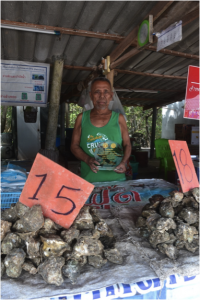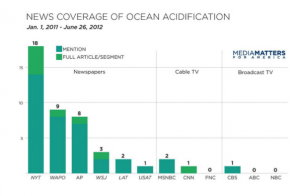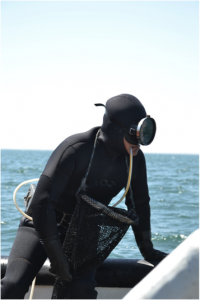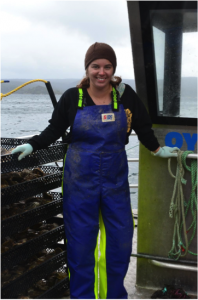This op-ed by Pete Knutson and Hing Ng (from the November 2016 edition of Pacific Fishing) reflects the analysis of the Working Group on Seafood and Energy, Global Ocean Health, and other organizations that worked with us to assess carbon policies around the world and determine which ones are strong enough to protect healthy seas and fisheries (and which ones fall short). After months of careful evaluation, the Working Group determined that a revenue neutral carbon tax proposed in Washington state would be weak, costly, and would obstruct better policies. The Working Group formally voted to oppose Initiative 732, a Washington state ballot measure, and to advocate stronger measures instead.
By Pete Knutson and Hing Ng
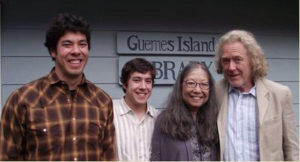 We’ve been fishing and direct marketing our salmon since before Ronald Reagan stripped the solar panels off the White House roof. In those days, the roaring two-cycle 6-71 in our old gillnetter was still considered clean and efficient enough to power a working boat. We fought to prevent oil spills and to protect salmon habitat, and not long ago we switched most of our production from air freight to freezer barges to reduce costs and carbon pollution. But until recently, hardly anyone understood how heavily our family business – and the seafood industry as a whole – depends on protecting oceans and rivers from the rising consequences of pollution from burning fossil fuels.
We’ve been fishing and direct marketing our salmon since before Ronald Reagan stripped the solar panels off the White House roof. In those days, the roaring two-cycle 6-71 in our old gillnetter was still considered clean and efficient enough to power a working boat. We fought to prevent oil spills and to protect salmon habitat, and not long ago we switched most of our production from air freight to freezer barges to reduce costs and carbon pollution. But until recently, hardly anyone understood how heavily our family business – and the seafood industry as a whole – depends on protecting oceans and rivers from the rising consequences of pollution from burning fossil fuels.
We have learned the hard way. In the last decade, it has become painfully obvious that emissions from coal, oil, and gas are already eroding Northwest fisheries, undercutting the future of both wild seafood and farmed shellfish.
We have no time to waste in confronting this gathering storm. That’s why we’re opposing Washington’s Initiative 732, which will be on ballots Nov. 8. Despite its good intentions, this “revenue neutral carbon tax” proposal is too weak to work, and it would obstruct better policies. As urgently as we need a carbon solution, we need it to be a real one. I-732 offers false hope.
It cannot cut emissions deeply enough to protect our waters, our harvests, and our climate.
Worse yet, Initiative I-732 would block the door to far more effective carbon policies that our state has a chance to adopt as soon as 2017. If you depend on healthy oceans, we urge you to vote this one down and work for stronger measures.
Carbon pollution does more than drive climate change, causing fish-killing hot spells in rivers and helping to crash Northwest salmon runs. It also acidifies seawater, undercuts planktonic foodwebs, clobbers larval shellfish, and increases both the growth and toxicity of poisonous algae blooms. Last winter, West Coast Dungeness crabbers lost most of their season because the fishery was shut down to protect consumers from a massive toxic algae bloom. That bloom also closed Washington’s razor clam fishery.
The Northwest is now viewed as the world’s “front line” in the struggle against acidification and other consequences of carbon pollution in the ocean.
We wish we could support I-732. Hundreds of volunteers worked hard to put it on the ballot. Unfortunately, this measure is fatally flawed. It would hoover up urgently needed funds from the proposed carbon tax and give away the money in tax breaks for business and the working poor.
It might even run deep into the red. Advocates of the measure contest this, but Washington’s Office of Financial Management estimated I-732 would dole out nearly $800 million more than it raises during its first six years (see tinyurl.com/j9awjfb).
Don’t get us wrong. Putting a price on carbon pollution is necessary. But giving away the money cripples the purpose of this initiative.
We can do far better by reinvesting the proceeds to grow a cleaner economy. Nine states from Maine to Maryland have slashed emissions from big power plants – far outperforming British Columbia’s revenue-neutral carbon tax – while accelerating job growth. How? They reinvest the money from a price on emissions to solve the carbon problem. The money from carbon pricing is pooled and invested in projects that help people afford to reduce pollution by burning less fuel, buying cleaner engines, insulating homes and buildings, upgrading inefficient cold storage and factory equipment, and switching to renewables and cleaner energy sources.
Initiative 732 can only drive up fuel prices. If that were a recipe for deep reductions in pollution, we might support this measure. It isn’t. Because I-732 fails to reinvest the money in energy solutions, it can deliver only a fraction of the emissions cuts required by existing Washington law.
A carbon price is too important to squander the proceeds.
Giving away the money in tax breaks also means I-732 would deny Washington the chance to join the growing network of states and nations (40 now and growing, with China climbing on board in 2017) that pool resources to combat the carbon problem. Washington would have nothing to contribute to the hat, so we would lose access to potential investments from other regions. We would be trying to “go it alone” against a global problem.
What about the extra money you would pay at the pump? Well, some of it would give Boeing yet another huge tax break.
We have real opportunities to solve the carbon problem. This measure isn’t one of them.
A sound policy would help finance projects that reduce emissions or bury carbon in soil and long-lasting products. Fishermen could benefit from investments to help drive down fuel consumption. That might even help our family replace our old 6-71, an inefficient but unstoppable diesel that first entered production in the 1930s.
It’s time for the seafood industry to champion stronger policies to protect healthy waters from carbon emissions. If you vote in Washington, vote no on I-732. Then put a shoulder to the wheel for real solutions.
How? Join the Working Group for Seafood and Energy (seafoodandenergy.org). It’s a forum for fishermen, growers, tribes, and fishery-dependent communities to pursue our shared goal of protecting fisheries and oceans from carbon emissions. This group helps us make a difference without eating up all our time. The Working Group was created at the request of industry and tribal leaders and is led by Brad Warren, a former editor of this magazine. To learn more about it, or participate, email info@globaloceanhealth.org.
Peter Knutson and Hing Ng run Seattle-based Loki Fish Co. with their sons, Jonah and Dylan.

